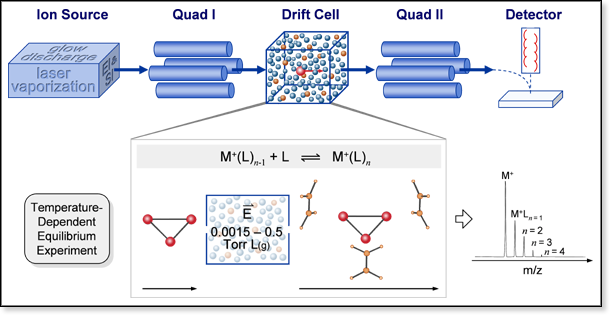|
A
schematic of the Quadrupole-Cell-Quadrupole (QCQ) instrument is shown
below. As with the MALDI-Sector
instrument, a variety of ion sources can be used with this instrument.
However, in recent years, the main focus of the experiments conducted
on the QCQ instrument has been the study of the interactions of transition
metal cluster ions with various neutral ligands. To accomplish this goal,
the primary method used for ionization has been pulsed laser vaporization
of a translating/rotating metal rod in an Ar bath gas. A XeCl excimer
laser is used in the experiment operating at a wavelength of 308 nm with
a power output of approximately 300 mJ/pulse.
Clusters exiting the source are mass selected
by the first quadrupole mass filter and injected into the drift/reaction
cell. When conducting a mobility
experiment, the cell is typically filled with 5 Torr of He. When temperature-dependent
equilibrium data or time-dependent
rate data is the focus of the experiment, the cell is filled with
a gas mixture typically composed of 0.0015 - 0.5 Torr of reactant gas
and 4.5 Torr of He. In some in cases, the cell is filled only with the
reactant gas at pressures up to 5 Torr. Clusters exiting the cell are
then mass selected by a second quadrupole mass filter and detected with
an electron multiplier. The upper mass limit of the quadrupoles is approximately
m/z = 1800. The QCQ cell has a temperature range of 80 - 800 K. Further
details concerning this instrument can be found in Kemper,
P. R.; Weis, P.; Bowers, M. T. Int. J. Mass Spectrom. Ion Proc.
1997, 160, 17-37.
|



